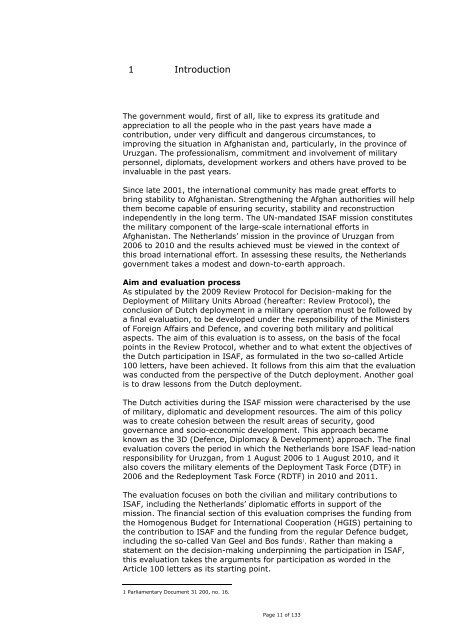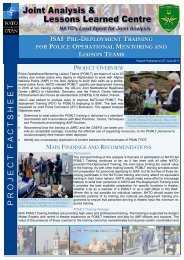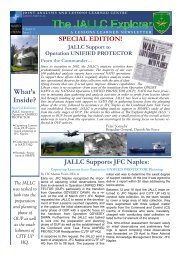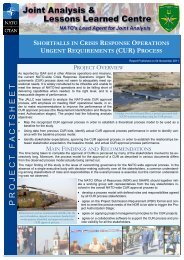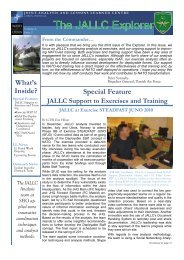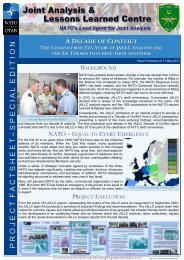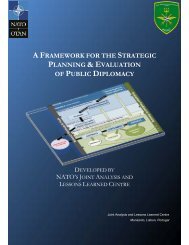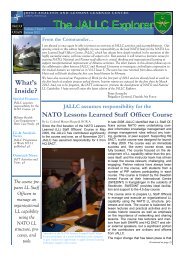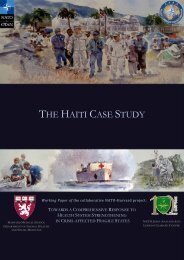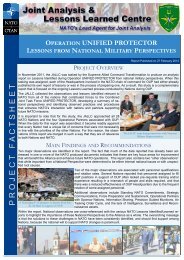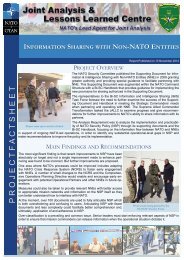Final evaluation Netherlands participation in ISAF 2006 - 2010
Final evaluation Netherlands participation in ISAF 2006 - 2010
Final evaluation Netherlands participation in ISAF 2006 - 2010
You also want an ePaper? Increase the reach of your titles
YUMPU automatically turns print PDFs into web optimized ePapers that Google loves.
1 IntroductionThe government would, first of all, like to express its gratitude andappreciation to all the people who <strong>in</strong> the past years have made acontribution, under very difficult and dangerous circumstances, toimprov<strong>in</strong>g the situation <strong>in</strong> Afghanistan and, particularly, <strong>in</strong> the prov<strong>in</strong>ce ofUruzgan. The professionalism, commitment and <strong>in</strong>volvement of militarypersonnel, diplomats, development workers and others have proved to be<strong>in</strong>valuable <strong>in</strong> the past years.S<strong>in</strong>ce late 2001, the <strong>in</strong>ternational community has made great efforts tobr<strong>in</strong>g stability to Afghanistan. Strengthen<strong>in</strong>g the Afghan authorities will helpthem become capable of ensur<strong>in</strong>g security, stability and reconstruction<strong>in</strong>dependently <strong>in</strong> the long term. The UN-mandated <strong>ISAF</strong> mission constitutesthe military component of the large-scale <strong>in</strong>ternational efforts <strong>in</strong>Afghanistan. The <strong>Netherlands</strong>’ mission <strong>in</strong> the prov<strong>in</strong>ce of Uruzgan from<strong>2006</strong> to <strong>2010</strong> and the results achieved must be viewed <strong>in</strong> the context ofthis broad <strong>in</strong>ternational effort. In assess<strong>in</strong>g these results, the <strong>Netherlands</strong>government takes a modest and down-to-earth approach.Aim and <strong>evaluation</strong> processAs stipulated by the 2009 Review Protocol for Decision-mak<strong>in</strong>g for theDeployment of Military Units Abroad (hereafter: Review Protocol), theconclusion of Dutch deployment <strong>in</strong> a military operation must be followed bya f<strong>in</strong>al <strong>evaluation</strong>, to be developed under the responsibility of the M<strong>in</strong>istersof Foreign Affairs and Defence, and cover<strong>in</strong>g both military and politicalaspects. The aim of this <strong>evaluation</strong> is to assess, on the basis of the focalpo<strong>in</strong>ts <strong>in</strong> the Review Protocol, whether and to what extent the objectives ofthe Dutch <strong>participation</strong> <strong>in</strong> <strong>ISAF</strong>, as formulated <strong>in</strong> the two so-called Article100 letters, have been achieved. It follows from this aim that the <strong>evaluation</strong>was conducted from the perspective of the Dutch deployment. Another goalis to draw lessons from the Dutch deployment.The Dutch activities dur<strong>in</strong>g the <strong>ISAF</strong> mission were characterised by the useof military, diplomatic and development resources. The aim of this policywas to create cohesion between the result areas of security, goodgovernance and socio-economic development. This approach becameknown as the 3D (Defence, Diplomacy & Development) approach. The f<strong>in</strong>al<strong>evaluation</strong> covers the period <strong>in</strong> which the <strong>Netherlands</strong> bore <strong>ISAF</strong> lead-nationresponsibility for Uruzgan, from 1 August <strong>2006</strong> to 1 August <strong>2010</strong>, and italso covers the military elements of the Deployment Task Force (DTF) <strong>in</strong><strong>2006</strong> and the Redeployment Task Force (RDTF) <strong>in</strong> <strong>2010</strong> and 2011.The <strong>evaluation</strong> focuses on both the civilian and military contributions to<strong>ISAF</strong>, <strong>in</strong>clud<strong>in</strong>g the <strong>Netherlands</strong>’ diplomatic efforts <strong>in</strong> support of themission. The f<strong>in</strong>ancial section of this <strong>evaluation</strong> comprises the fund<strong>in</strong>g fromthe Homogenous Budget for International Cooperation (HGIS) perta<strong>in</strong><strong>in</strong>g tothe contribution to <strong>ISAF</strong> and the fund<strong>in</strong>g from the regular Defence budget,<strong>in</strong>clud<strong>in</strong>g the so-called Van Geel and Bos funds 1 . Rather than mak<strong>in</strong>g astatement on the decision-mak<strong>in</strong>g underp<strong>in</strong>n<strong>in</strong>g the <strong>participation</strong> <strong>in</strong> <strong>ISAF</strong>,this <strong>evaluation</strong> takes the arguments for <strong>participation</strong> as worded <strong>in</strong> theArticle 100 letters as its start<strong>in</strong>g po<strong>in</strong>t.1 Parliamentary Document 31 200, no. 16.Page 11 of 133


